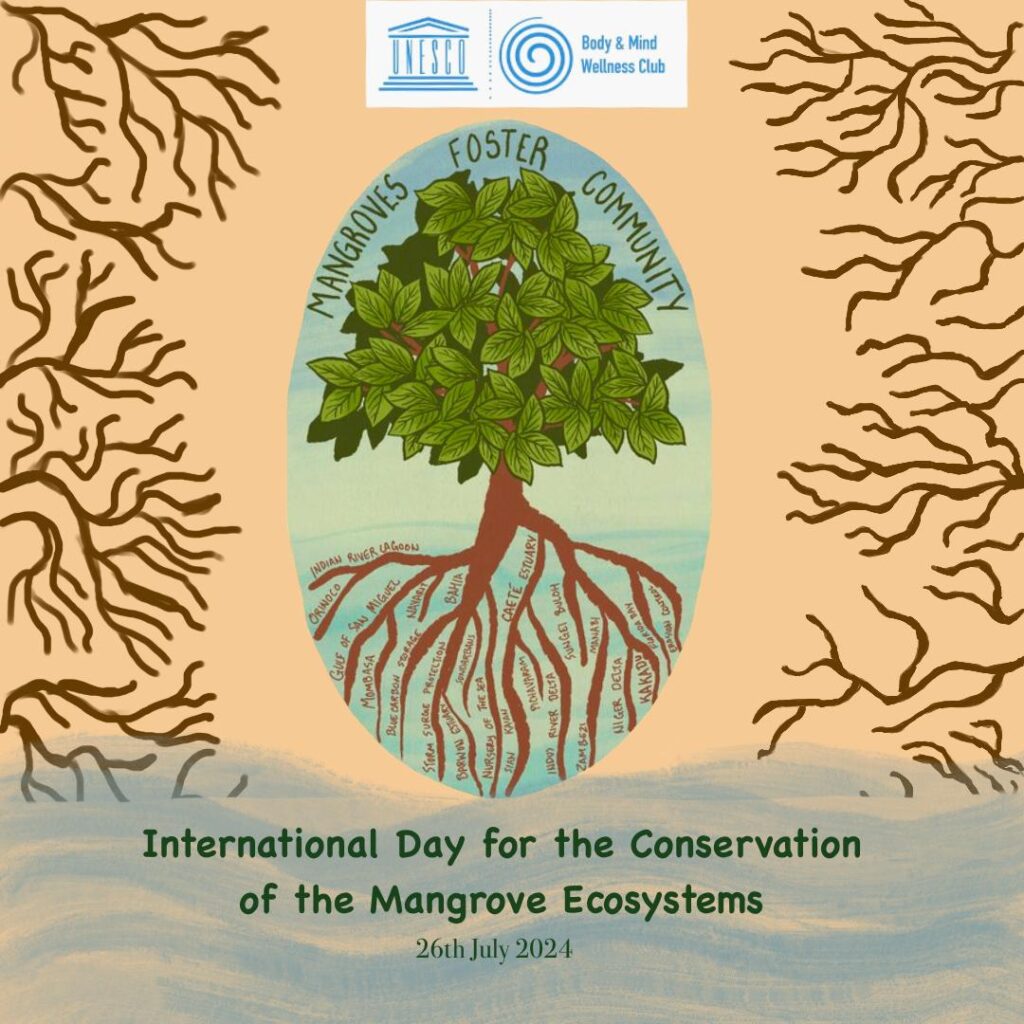
Mangrove ecosystems are some of the most valuable and unique habitats on our planet. Found in tropical and subtropical coastal regions, these salt-tolerant forests are vital to both environmental health and human livelihoods. Every year on July 26, we celebrate the International Day for the Conservation of Mangrove Ecosystems to shine a spotlight on their importance and the urgent need to protect them.
Why Mangroves Matter
Mangroves are not just any forests; they play critical roles in our environment and communities:
- Biodiversity Hotspots: Mangroves are home to a wide variety of wildlife, including fish, birds, and crustaceans. They act as nurseries for many marine species, providing a haven for young fish to grow before heading out to sea. This biodiversity is crucial for maintaining healthy marine ecosystems.
- Coastal Protection: One of the remarkable features of mangroves is their ability to protect coastlines. Their dense root systems help prevent soil erosion and reduce the impact of storm surges and waves, acting as a natural barrier that protects coastal communities from natural disasters.
- Climate Change Warriors: Mangroves are exceptional at storing carbon, more so than many other forest types. This makes them powerful allies in the fight against climate change. By absorbing and storing large amounts of carbon dioxide, they help mitigate the effects of global warming.
- Supporting Livelihoods: Many people living in coastal areas depend on mangroves for their livelihoods. These forests provide resources such as fish, timber, and honey. They also attract tourists, supporting local economies through eco-tourism and recreation.
The Threats Mangroves Face
Despite their many benefits, mangroves are under severe threat from human activities and environmental changes:
- Deforestation and Land Conversion: Mangrove forests are often cleared to make way for agriculture, aquaculture, and urban development. This destruction leads to the loss of critical habitats and threatens the species that rely on them.
- Pollution: Mangroves are highly sensitive to pollution from industrial runoff, agricultural chemicals, and plastic waste. These pollutants can degrade the quality of the water and soil, harming the plants and animals that live there.
- Climate Change: Rising sea levels, increased storm intensity, and changes in rainfall patterns due to climate change pose significant risks to mangroves. These environmental shifts can alter the salinity and water flow in mangrove ecosystems, making it difficult for them to survive.
- Unsustainable Practices: Overexploitation of mangrove resources, such as excessive logging and overfishing, leads to ecosystem degradation. Unsustainable tourism can also damage these delicate environments, causing physical harm and pollution.
What We Can Do
Conserving mangroves requires a collective effort. The International Day for the Conservation of Mangrove Ecosystems encourages us to take action through various strategies:
- Creating protected areas and launching restoration projects are crucial steps. By replanting and rehabilitating damaged mangrove forests, we can help them regain their health and ecological functions.
- It’s important to use mangrove resources wisely. This includes adopting sustainable fishing practices, regulating coastal development, and promoting eco-friendly tourism to ensure that mangroves are used in a way that does not deplete or harm them.
- Local communities play a vital role in mangrove conservation. Education and community-based management programs can empower people to protect and sustainably use these ecosystems. When communities are involved in decision-making, conservation efforts are more effective and culturally appropriate.
- Effective policies and legal frameworks are essential for protecting mangroves. Governments, NGOs, and international organizations must collaborate to enforce regulations, secure funding, and advocate for global cooperation in mangrove conservation.
UNESCO BMW’s Involvement
The UNESCO BMW Club is actively involved in the conservation of mangrove ecosystems, particularly highlighted on the International Day for the Conservation of Mangrove Ecosystems on July 26. The club raises awareness about the importance of mangroves through educational campaigns and supports restoration projects by partnering with local and international organizations. By engaging local communities in conservation efforts and promoting sustainable practices such as responsible fishing and eco-friendly tourism, the club ensures the long-term protection of these vital habitats. Additionally, the UNESCO BMW Club advocates for strong policies and collaborates with various stakeholders to create a supportive framework for mangrove conservation globally.
UNESCO BMW’s Vision
Our vision mission encompasses three main goals that are also in line with this occasion today and engage people of all ages, especially the youth improvement of the inner ecosystem, enhancement of inner creativity through arts and crafts, and, lastly, encouragement of keeping the oceans clean.
By:- Srija Ramisetty
Sources
- https://www.nature.org/en-us/about-us/where-we-work/united-states/florida/stories-in-florida/why-mangroves-important/#:~:text=Mangroves%20provide%20natural%20infrastructure%20to,help%20bind%20and%20build%20soils.
- https://www.reefcheck.org.my/what-we-do?gad_source=1&gclid=CjwKCAjw7NmzBhBLEiwAxrHQ-TkvYuaBeChYq_7naB7bd91RlWWFuCSnPMAxWbpf0oBbwY5fV-8q1hoC5HwQAvD_BwE
- https://blueventures.org/?utm_term=how%20to%20protect%20mangroves&utm_campaign=&utm_source=adwords&utm_medium=ppc&hsa_tgt=kwd-359147060541&hsa_grp=162273959416&hsa_src=g&hsa_net=adwords&hsa_mt=b&hsa_ver=3&hsa_ad=698111056050&hsa_acc=6378993135&hsa_kw=how%20to%20protect%20mangroves&hsa_cam=21243963054&gad_source=1&gclid=CjwKCAjw7NmzBhBLEiwAxrHQ-YSUuDGpq6X5s68mHqZRpLb1ffRqOPZWTBued2k_exdY5WD23nGtCxoC3MsQAvD_BwE
- https://en.wikipedia.org/wiki/International_Day_for_the_Conservation_of_the_Mangrove_Ecosystem#:~:text=The%20International%20Day%20for%20the,every%20year%20on%2026%20July.&text=This%20International%20Day%20was%20designated,first%20held%20in%20July%202016.
- https://unescobmw.org/